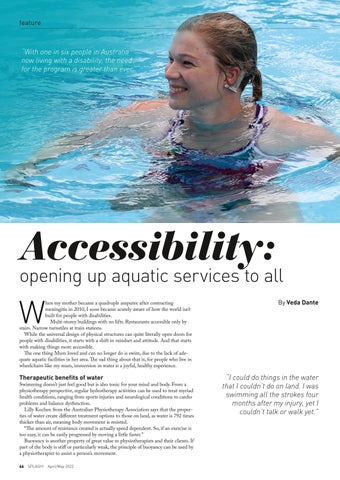feature
“With one in six people in Australia now living with a disability, the need for the program is greater than ever.”
Accessibility:
opening up aquatic services to all
W
hen my mother became a quadruple amputee after contracting meningitis in 2010, I soon became acutely aware of how the world isn’t built for people with disabilities. Multi-storey buildings with no lifts. Restaurants accessible only by stairs. Narrow turnstiles at train stations. While the universal design of physical structures can quite literally open doors for people with disabilities, it starts with a shift in mindset and attitude. And that starts with making things more accessible. The one thing Mum loved and can no longer do is swim, due to the lack of adequate aquatic facilities in her area. The sad thing about that is, for people who live in wheelchairs like my mum, immersion in water is a joyful, healthy experience.
Therapeutic benefits of water
Swimming doesn’t just feel good but is also tonic for your mind and body. From a physiotherapy perspective, regular hydrotherapy activities can be used to treat myriad health conditions, ranging from sports injuries and neurological conditions to cardio problems and balance dysfunction. Lilly Kochen from the Australian Physiotherapy Association says that the properties of water create different treatment options to those on land, as water is 792 times thicker than air, meaning body movement is resisted. “The amount of resistance created is actually speed dependent. So, if an exercise is too easy, it can be easily progressed by moving a little faster.” Buoyancy is another property of great value to physiotherapists and their clients. If part of the body is stiff or particularly weak, the principle of buoyancy can be used by a physiotherapist to assist a person’s movement. 66
SPLASH!
April/May 2022
By Veda Dante
“I could do things in the water that I couldn’t do on land. I was swimming all the strokes four months after my injury, yet I couldn’t talk or walk yet.”
